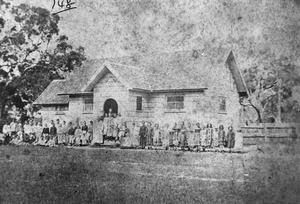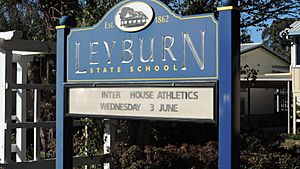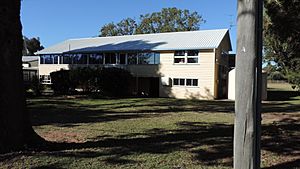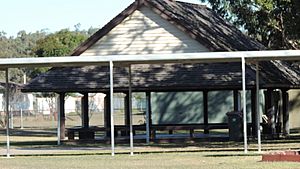Leyburn State School facts for kids
Quick facts for kids Leyburn State School |
|
|---|---|
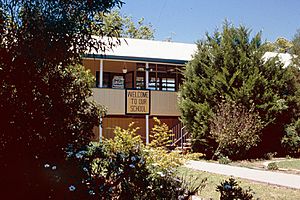
Leyburn State School, 1995
|
|
| Location | Peter Street, Leyburn, Southern Downs Region, Queensland, Australia |
| Design period | 1870s–1890s (late 19th century) |
| Built | 1883–1930s |
| Official name: Leyburn State School, Leyburn National School | |
| Type | state heritage (built) |
| Designated | 21 October 1992 |
| Reference no. | 600827 |
| Significant period | 1880s–1900s (historical) 1880s–1930s (fabric) 1880s–ongoing (social) |
| Significant components | residential accommodation – headmaster's house, school/school room, play shed |
| Lua error in Module:Location_map at line 420: attempt to index field 'wikibase' (a nil value). | |
Leyburn State School is a special old school located on Peter Street in Leyburn, Queensland, Australia. It is considered a 'heritage-listed' site, which means it is an important historical place protected for future generations. The school was built over many years, from 1883 into the 1930s. It was also known as Leyburn National School and was added to the Queensland Heritage Register on October 21, 1992.
Contents
The Story of Leyburn State School
Leyburn started as a small settlement in the 1840s. It grew to help settlers and travellers using the stock route, which was first explored by the Leslie brothers in 1840. The town was officially named Leyburn in 1853.
By 1872, Leyburn had a state school, a church, a police station, a court house, shops, and hotels. It was a quiet town, mostly known for carriers who transported goods on the road to Toowoomba and Goondiwindi. Many men worked on nearby farms and returned to their families in Leyburn on weekends.
Leyburn's Early Importance
Leyburn was an important centre for the Darling Downs region. From 1852, it became a place where mail was sent out to other areas. In 1872, Leyburn was connected to the electric telegraph system, making it a key station for messages between Sydney and Brisbane.
The town also had important government services. In 1861, Leyburn became a place for holding courts, and a police magistrate was appointed. A lock-up (jail) was built, followed by a court house in 1867.
The First School Building
Leyburn's first primary school, then called the National School, opened on January 13, 1862. It was one of the first schools in Queensland, starting with 46 students in a temporary hut.
A purpose-built school house opened on January 22, 1865. It was funded by local donations and government money. The school was a low-set timber building with a large classroom and a smaller one. It had a covered porch at the front and a verandah added later at the back.
The Playshed and Its History
The playshed, a covered outdoor area, was built in 1883. It was located near the school house and the teacher's residence. The local school committee asked for tenders (bids) to build the playshed in late 1882.
William Clark's bid of £151 was accepted, even though it was not the lowest. This was because he was known for excellent work. The playshed was designed as a general-purpose space, offering shelter from the weather.
Timber flooring was added to the playshed in 1887. The words "All are Welcome" were painted on one beam, likely in the early 1900s. In 1973 and 1974, the playshed's roof was re-shingled with 10,000 ironbark shingles by the Parents and Citizens Association. Today, the playshed's shape is part of the school's emblem.
A New School Building
The current main school building opened on October 20, 1934. The old school was still strong but considered very old-fashioned. It was decided to sell the old school and residence and build new ones in a different spot.
The new school and teacher's residence were built on Peter Street. The school cost about £283. It was a raised timber building, which meant it had space underneath for play. It had one classroom for 40 students and verandahs at the front and back. This type of school building was common for country schools between 1930 and 1946.
The new teacher's residence, costing £700, was a standard type of house for married male headteachers. These homes were built to encourage teachers to work in country areas and to provide someone to look after the school site.
Soon after the new school opened, the old school house was moved to MacIntyre Street and is still used as a private home. The old teacher's residence was also sold and moved.
School Changes Over Time
Since it was built, the school has had several changes. In 1951, the classroom and verandahs were extended. In 1957, part of the eastern verandah was enclosed to create a library. In 1959, the building was changed to have two classrooms. In 1976, a library and health service room were added to the southern end of the building.
The school celebrated its 125th anniversary in 1987. In the same year, a swimming pool, used by the local community, was opened. In 2015, there were 36 students from Prep to Year 6, with 4 teachers.
What Leyburn State School Looks Like
Leyburn is a small country village about 50 kilometres northwest of Warwick. The school grounds are on the western edge of the town. The main school building faces Peter Street. Behind it, under some camphor laurel trees, is the playshed.
To the south of the school is the teacher's residence. To the north is a portable classroom building. To the east are the sports fields, and to the northeast are the tennis court, toilet block, swimming pool, and change sheds. There are also several silky oak trees around the edges of the school grounds.
The School Building
The school building has two classrooms that are now used as one large space. It also has an office, a storage room, and a staff area. It is a high-set timber building with a gabled roof made of corrugated iron.
The original classroom walls are lined with tongue-and-groove timber boards. Newer areas have fibrous cement sheets. On the west side, there is an open verandah with racks for students' school bags. There are timber stairs at the front and back. On the east side, there is a small landing with the original school bell. The space underneath the school is mostly open and still has some old school furniture.
The Playshed
The playshed is an open timber structure that is shaped like a rectangle. It has a gabled roof made of large timber sections and covered with hand-split hardwood shingles. The roof has wide overhangs on all four sides.
The roof is held up by ten strong timber posts. These posts are bolted to other posts that are set into the ground. There are also triangular supports for the posts. The playshed has a raised timber floor, one step above the ground. Along the inside of the posts, there are timber benches. The words "All Are Welcome" are painted on one of the beams on the north side.
Why Leyburn State School is Important
Leyburn State School was added to the Queensland Heritage Register on October 21, 1992, because it meets several important criteria.
Showing Queensland's History
The school started in 1862 and moved to its current site in 1865. It is important because it was one of the first 'national schools' in the colony of Queensland.
The school, along with other old buildings in Leyburn, shows how the town developed in the 1800s. The playshed, the old trees, and the school building and residence (both built in 1934) all help tell the story of the school's growth.
Rare and Special Features
The playshed is a rare example of a timber building with a shingled roof that still exists. It is even more special because another shingled building, St Augustine's Anglican Church (built in 1871), is also in Leyburn. Buildings made with large, carefully joined timber sections are also uncommon today.
Typical School Characteristics
The school is a key part of Leyburn's townscape. Leyburn is a great example of an early Queensland town that served the Darling Downs, which was Queensland's first and richest farming area.
The Leyburn Playshed is one of the oldest surviving playsheds, similar to those at Brisbane Central State School (1877) and Kalkie State School (1879). Playsheds were a common type of building in schools during the 1800s.
The school building is a type that was often used for small country schools. The teacher's residence is also a specific type built between the two World Wars. It shows how the government provided homes for married male headteachers to encourage them to teach in country areas and to have someone living on site to look after the school.
Beautiful and Well-Designed
The playshed is considered very beautiful and well-designed. It successfully combines local building styles and materials. It was built to suit the climate and to handle changes in student numbers.
Strong Community Connection
The school has a long and strong connection with the Leyburn community. It has been both the centre for local education and a place for community activities. The playshed, built in 1883, has become a symbol for both the school and the local community.
Important Builders and Organizations
The school and residence are good examples of building types created by the Department of Public Works for the Department of Public Instruction.


